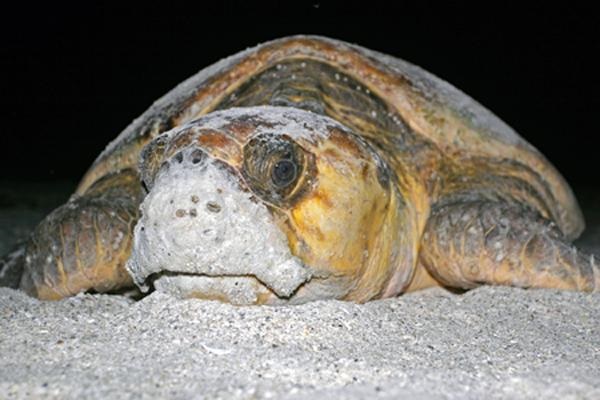
Sea Turtles See Things Differently
That is, when it comes to lights on our homes and businesses near their nesting beaches. Humans have long-known that artificial light can have negative consequences for many nocturnal animals, including nesting and hatching sea turtles. However, it has only been through fairly recent research that we are beginning to understand the reasons behind some of these effects and developing better lighting (or non-lighting) strategies and alternatives to protect our treasured marine turtle species.
Mother sea turtles that nest on Florida Panhandle beaches are “hard-wired” for nighttime activity when it comes to digging their nest cavities and depositing eggs. Likewise, their babies typically leave their sandy nests under cover of darkness, scampering to the Gulf of Mexico. This nocturnal behavior is important for avoiding predators that would have an easy meal of a baby turtle crossing the open beach in the light of day. However, even hatchlings emerging at night face a number of other obstacles. Once in the water there are a many aquatic predators that will not hesitate to gobble up a baby turtle. On average, it is estimated that only about 1 in 1000 babies survive to reach adulthood. With those odds, it would be wise for us to do anything we can to minimize additional threats or hazards during the short but crucial time these marine reptiles spend on the narrow thread of beachfront that we share with them.
One thing we can do involves reducing the disorienting effects of artificial light near our sea turtle nesting beaches. The term “phototactic” is used to describe organisms that are stimulated to move towards or away from light. Nesting females have been shown to avoid bright areas on the beach but hatchlings tend to be attracted to the brightest source of light when they emerge from the sand. On a nesting beach with no artificial lighting, any natural light from the moon or stars is reflected off the water, creating a much brighter horizon in that direction. This naturally attracts the hatchlings in the right direction. Lights from human sources can appear very bright in comparison and quite often draw babies over the dunes and into harm’s way on roadways, from predators, or simply by exposure once the sun comes up.
Many beachfront property owners have learned about this threat and have taken this issue to heart by reducing the amount of light on their property and eliminating or replacing lights visible from the nesting beach with sea turtle-friendly lighting. There are three rules to follow when retrofitting or installing new lighting near the beach.
- Keep it Long: Long-wave-length lighting that is still in the portion of the spectrum visible to humans includes amber, orange and red light. Manufacturers are now making highly efficient LED bulbs that are certified by the FWC as turtle-friendly.
- Keep it Low: Many times lighting needed for safety of access can be placed low enough to be unseen from the nesting beach.
- Keep it Shielded: Fixtures that are in line-of-site to the nesting beach need to be recessed to shield the bulb from being directly visible. The correct long-wave-length bulb should also be used in these shielded fixtures.
Remember, exterior lighting is not the only danger turtles face from our lights. Unobstructed interior lights seen through windows and doors can be just as detrimental. The best solution here is to tint beach-facing glass with a 15% transmittance tinting product. This will save money on cooling bills as well as protect interior furnishings and avoid the possibility that someone in your house might leave the blinds or curtains open accidentally during turtle season. If you have questions regarding turtle-safe lighting practices in Florida there are many resources available through the Fish and Wildlife Conservation Commission the National Marine Fisheries Service, the Sea Turtle Conservancy, and your local UF/IFAS County Extension offices. If you really want to get into the nitty-gritty of turtle lighting and ways to protect turtles check out this FWC publication on assessing and resolving light pollution problems and this model lighting ordinance from UF’s Levin College of Law. Most Florida coastal counties have already adopted sea turtle lighting ordinances so you should also check your local county codes for this issue. Let’s help keep sea turtles in the dark, where they need to be.

